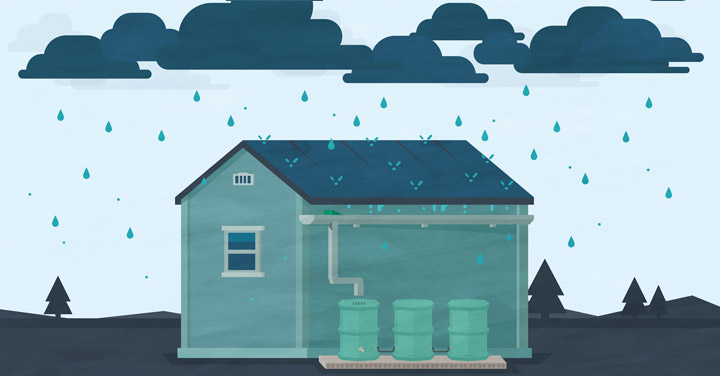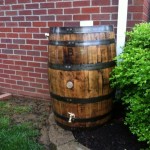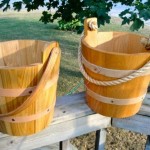(and How to Do It)
Rain, rain, go away? Don’t be so quick to reject the water falling from the sky. Turns out harvesting rainwater is an ancient practice with loads of modern-day benefits. Here’s the lowdown on the practice, and how to put the rain that falls on your home to good use.
What Is Rainwater Harvesting?
Quite simply, rainwater harvesting is the practice of collecting and storing rainwater (typically from the roof of a home or building) for later use. Rainwater harvesting systems range from the very simple—a rain barrel placed under the downspout of a building’s gutters—to more complex options that plug into a building’s plumbing system. The practice is popular across a wide range of demographics, from rural gardeners to people living in urban centers.
Even though rainwater harvesting has been practiced for thousands of years, it’s only beginning to inspire the formation of an organized industry. In recent decades the American Rainwater Catchment Systems Association, which promotes sustainable rainwater practices as a means of solving water and energy challenges throughout the world, has emerged as an industry leader. Despite its influence, there are currently no national standards regulating the collection and use of rainwater, although many states and municipalities have instated laws around its use.
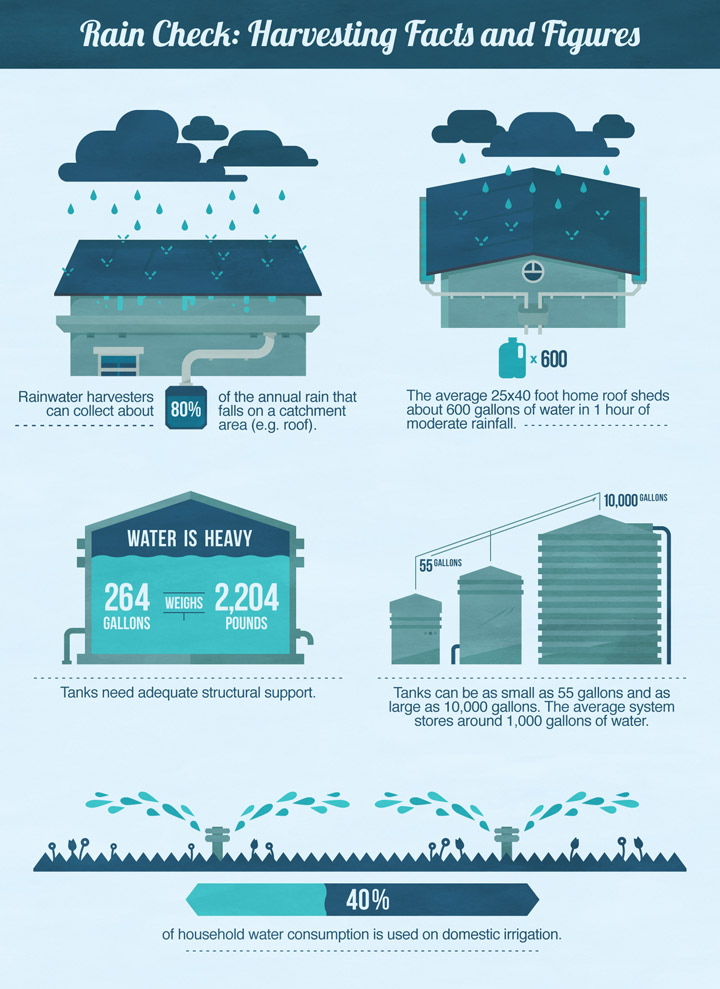 The Benefits of Rainwater Harvesting
The Benefits of Rainwater Harvesting
For those whose communities allow them to collect rainwater, the practice offers a number of environmental and economic benefits. For starters, harvesting rainwater helps control storm-water runoff, which reduces the risk of erosion in gardens and around downspouts, minimizes the impact on local storm-water infrastructure and combined sewer systems, and helps reduce the threat of flooding.
Not only does rainwater harvesting help environmental and human infrastructure cope with large amounts of rain (and save municipalities money), but it also puts that water to good use. Stored rainwater can be used for both outdoor and indoor uses, including landscape irrigation, watering plants or gardens, toilet flushing, laundry, washing cars or patio furniture, and even bathing or drinking (although using rainwater for drinking requires treatment prior to use).
Rainwater’s many uses can help people save money on utility bills—especially because the water is practically free (minus the cost of the collection system). The roof of a 1,000-square-foot house can collect around 600 gallons per one inch of rain—that’s enough free water to fill more than 15 bathtubs! Additionally, some communities offer rebates or reduced fees to homeowners who practice rainwater harvesting.
Another great benefit of rainwater harvesting is it decentralizes the water supply. That means instead of being completely dependent on municipal sources, consumers who choose to harvest rainwater have more control over how their water is sourced, treated, and put to use. In fact, some people are motivated to install rainwater-harvesting systems for the sole purpose of having a private, protected source of water in case of emergency or if the municipal water supply becomes contaminated.
How to Harvest Rainwater at Home
Ready to hop on the rainwater harvesting train? It’s helpful to ask yourself a few questions before getting started. Most importantly, consider:
- For what purpose(s) do you want to use rainwater?
The way you plan to use rainwater will determine how much rainwater you’ll need to collect, the system you’ll need to use, and the costs, equipment, and maintenance involved. For example, collecting rainwater for watering plants will require a vastly different system than using rainwater for in-home activities, such as flushing the toilet, showering, or doing laundry. - What are the laws in your area concerning rainwater harvesting?
Some states consider rainwater the property of the state and prohibit its collection, while other regions encourage homeowners to participate in rainwater harvesting. Consult with your local government (try the health department or environmental quality department) before setting up any harvesting systems.
Once you’ve determined the answers to the questions above, it’s time to choose a rainwater harvesting system. While they vary in size, complexity, and function, all systems share the same basic components:
- Catchment area: This is the area that first captures the rainfall; it is most commonly the roof of a building or house.
- Conveyance system: This refers to whatever moves the water from the roof to its storage area—for example, gutters, downspouts, and piping.
- Storage system: Typically a barrel, cistern, or tank, this is what collects the rainwater for later use.
- Distribution system: This refers to whatever is used to move the water from the storage system to wherever it’s being used—whether that’s a watering can or an underground irrigation system.
 In their simplest forms, rainwater harvesting systems consist of a barrel placed under a building’s downspout. Other options include aboveground and underground cisterns, drip irrigation systems, professionally landscaped rain gardens, and systems that hook directly into a building’s plumbing. The specifications of more advanced systems (which can cost thousands of dollars) will vary based on your needs and the system used.
In their simplest forms, rainwater harvesting systems consist of a barrel placed under a building’s downspout. Other options include aboveground and underground cisterns, drip irrigation systems, professionally landscaped rain gardens, and systems that hook directly into a building’s plumbing. The specifications of more advanced systems (which can cost thousands of dollars) will vary based on your needs and the system used.
If you’re interested in simple rainwater collection, your best bet is the popular barrel-under-a-downspout system. High-quality rainwater barrels tend to cost approximately $100 and should include a spigot that allows users to easily fill up watering cans or attach a hose. DIY-inclined people may choose to build their own barrel or customize a large garbage can. If you want to give DIY a try, check out this resource for detailed instructions.
Once you’ve procured your barrel(s), there are a few important factors to keep in mind prior to and after installation:
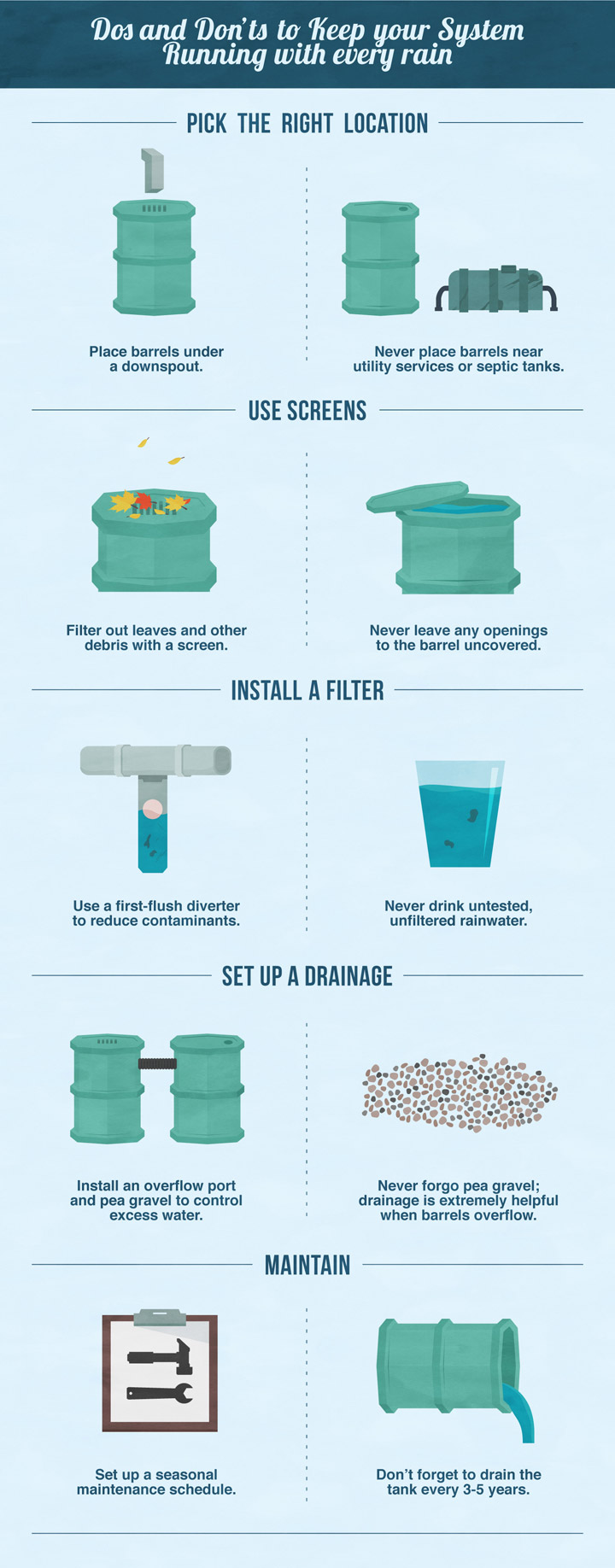 Location: Rain barrels can be installed along houses, under decks, or in other unused spaces. Locate barrels under a downspout (ideally one that’s closest to the area where you’ll want to be using the water). Be sure not to place the barrel near utility services or septic tanks.
Location: Rain barrels can be installed along houses, under decks, or in other unused spaces. Locate barrels under a downspout (ideally one that’s closest to the area where you’ll want to be using the water). Be sure not to place the barrel near utility services or septic tanks.
Roof: The material of your roof will affect how much water can be collected in addition to the quality of the water. As stated earlier, the average (25 foot by 40 foot) home roof sheds approximately 600 gallons of water in one hour of moderate rainfall. That means every downspout attached to your roof will divert a portion of those gallons to the barrel underneath it. The more barrels you have, the more rainwater you can collect.
Screens: It’s helpful to place a screen over the area where the downspout meets the gutter in order to help filter out leaves and other debris and to keep the downspouts from getting clogged. A fine-mesh aluminum window screen can help keep insects out of the water in the barrel, as well. Also be sure to keep all openings to the barrel covered.
Installation: The higher you raise the barrel(s), the better the water pressure when you use the spigot. A simple way to raise the barrel is to place it on top of a flat bed of cinder blocks. Start by digging a four-inch deep area the length and width of the cinder block base. Fill the area with quarter-inch pea gravel in order to help you level the cinder blocks (this will also help to keep the foundation dry). Line the area with the cinder blocks and then position the barrel on top. Note: Some municipalities regulate the manner in which rain barrels can be installed; some even require the base to be designed by a structural engineer. Be sure to review your community’s rules before installing your rainwater harvesting system.
Usage: Because rain can wash various contaminants into the water (for example, bird poop, bacteria, parasites, or chemicals from your roof), experts advise that water collected in rain barrels not be used for drinking, bathing, or watering plants you intend to eat unless it is specifically treated for these uses.
Filters: There are a variety of filters and disinfection systems that can treat water to acceptable levels of quality. A “first flush diverter” is a simple device that can help reduce contaminants by removing the first water that comes out of the system, since it’s likely to contain the most contaminants. Water intended for drinking needs to be filtered, disinfected, and tested regularly.
Overflow: During particularly heavy rains, it’s possible the barrel may overflow. The pea gravel under the cinder blocks will help to drain this excess water away from the barrel. You may also choose to install an overflow port near the top of the barrel (attaching it to a hose can divert excess water directly to a garden or lawn).
Maintenance: A great way to help keep your rainwater free of contaminants is to follow the seasonal maintenance schedule outlined in this guide. Also be sure to visually inspect the system’s components regularly and make any replacements or repairs immediately. Drain the tank a minimum of every three to five years in order to check for deterioration and clean out debris.
And there you have it: the basics of rainwater harvesting. Now get out there and dance in (or collect) the rain!
Thinking of rainwater harvesting after reading this article? Check out these women’s boots before you go out sloshing through puddles. — http://www.custommade.com/gallery/custom-shoes/
